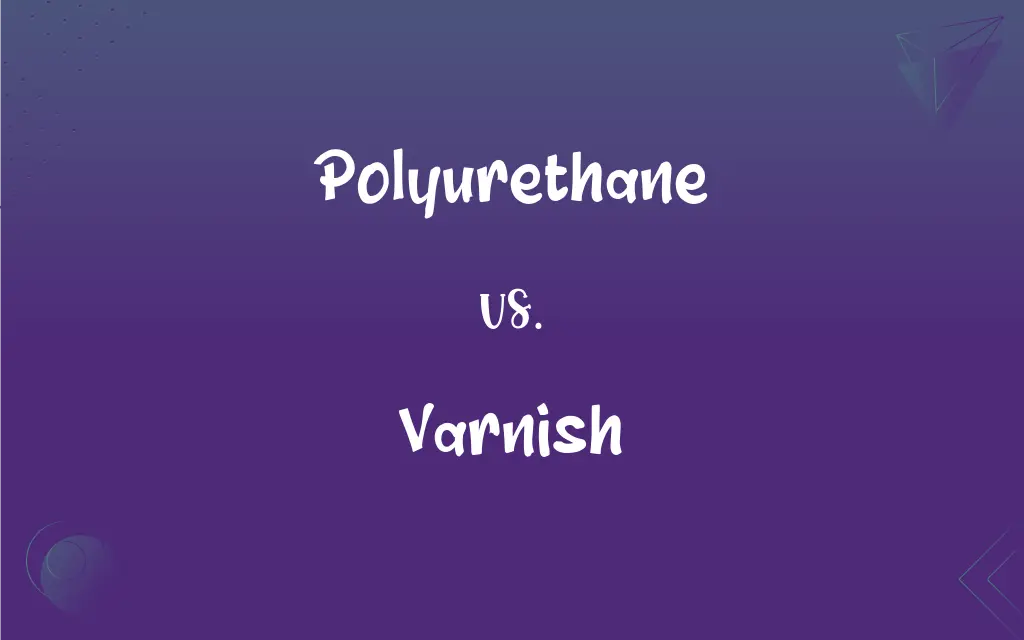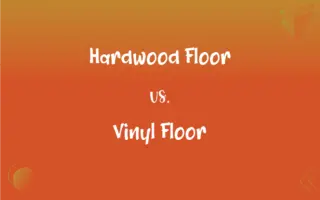Polyurethane vs. Varnish: What's the Difference?
Edited by Janet White || By Harlon Moss || Published on January 30, 2024
Polyurethane is a synthetic resin used for durable finishes, while varnish is a traditional protective finish primarily derived from resins and oils.

Key Differences
Polyurethane is a type of synthetic resin known for its durability and resistance to damage, making it ideal for floors and furniture. Varnish, on the other hand, is an older type of finish composed of natural oils and resins, offering a classic aesthetic but with less resistance to wear and tear.
Polyurethane finishes are available in various sheens and can be either water-based or oil-based. They tend to add a slight color tint and are more resistant to water and chemicals. Varnish, traditionally used for its aesthetic appeal, enhances the wood's natural color and grain but requires more frequent reapplication.
In terms of application, polyurethane can be more forgiving for DIY enthusiasts, as it's less prone to showing brush strokes. Varnish, while providing a beautiful finish, often requires more skill to apply evenly without leaving brush marks.
When considering environmental factors, water-based polyurethane is less toxic and emits lower volatile organic compounds (VOCs) compared to oil-based versions. Varnish typically has higher VOC levels due to its solvent-based nature.
For maintenance, polyurethane finishes are easier to clean and maintain, as they do not require frequent reapplication. Varnish, while offering a traditional look, may require more upkeep to maintain its appearance over time.
ADVERTISEMENT
Comparison Chart
Base
Synthetic resin
Natural oils and resins
Durability
Highly durable
Less durable
Appearance
Slight color tint
Enhances wood grain
Environmental Impact
Lower VOCs in water-based
Higher VOCs
Maintenance
Easier to maintain
Requires more upkeep
ADVERTISEMENT
Polyurethane and Varnish Definitions
Polyurethane
Polyurethane is a versatile polymer used in foam production.
The sofa's cushions were filled with soft polyurethane foam for comfort.
Varnish
Varnish is a solution of resin in an oil or solvent.
He mixed the varnish carefully before applying it to the woodwork.
Polyurethane
Polyurethane is a synthetic resin used for hard-wearing surface coatings.
The tabletop was coated in polyurethane to protect it from scratches.
Varnish
Varnish is used in fine art to protect paintings from dust and fading.
The artist applied a layer of varnish to preserve the painting's colors.
Polyurethane
Polyurethane is employed in the automotive industry for insulation and body parts.
The car's insulation was made from durable polyurethane material.
Varnish
Varnish is used as a final finish on musical instruments.
The violin had a glossy finish thanks to the layer of varnish.
Polyurethane
Polyurethane is a component in textiles to add elasticity and durability.
The stretchy fabric of the jacket was made with polyurethane fibers.
Varnish
Varnish enhances the natural beauty of wood.
The varnish brought out the rich, natural grain of the oak table.
Polyurethane
Polyurethane is used in adhesives and sealants for its strong bonding properties.
We used polyurethane glue to repair the broken chair leg.
Varnish
Varnish is a transparent, hard protective finish or film.
The wooden boat was coated with varnish to protect it from water damage.
Polyurethane
Any of various thermoplastic isocyanate polymers, widely varying in flexibility, used in tough chemical-resistant coatings, adhesives, and foams.
Varnish
A liquid that contains a solvent and an oxidizing or evaporating binder and is applied to a surface to produce a hard, transparent finish after evaporation and curing.
Polyurethane
(organic chemistry) Any of various polymeric resins containing urethane links; used in very many industrial and domestic applications.
Varnish
The smooth coating or gloss resulting from the application of this liquid
Wear dulled the floor's varnish.
Polyurethane
Any polymer containing [-NH.CO.O-] linkages; such polymers are much used as the basis of light but rigid foams for packaging (polyurethane foam) and for hard coatings, as on floors.
Polyurethane
Any of various polymers containing the urethane radical; a wide variety of synthetic forms are made and used as adhesives or plastics or paints or rubber
FAQs
Does varnish require frequent reapplication?
Yes, varnish may need more frequent reapplication to maintain its appearance.
Is polyurethane suitable for outdoor use?
Yes, especially oil-based polyurethane, which is more resistant to environmental factors.
Does varnish provide UV protection?
Some varnishes include UV protectants, but they generally offer less UV resistance than polyurethanes.
Can water-based polyurethane be applied over varnish?
It's not recommended without proper surface preparation, as adhesion issues may arise.
What is varnish used for?
Varnish is used as a protective finish for wood, in fine art, and on musical instruments.
Can polyurethane be used on floors?
Yes, polyurethane is a popular choice for hardwood floor finishes.
Are there different types of polyurethane?
Yes, polyurethane comes in water-based and oil-based forms, each with different properties.
Does polyurethane yellow over time?
Oil-based polyurethane can yellow, while water-based varieties remain clearer.
What is polyurethane used for?
Polyurethane is used for surface coatings, foam production, adhesives, and in the automotive and textile industries.
Is polyurethane more durable than varnish?
Yes, polyurethane generally offers greater durability and resistance to wear.
Can varnish enhance the appearance of wood?
Yes, varnish enhances the wood's natural color and grain.
Is varnish water-resistant?
Yes, varnish offers water resistance, but less so than polyurethane.
Can varnish be used over paint?
Yes, but the surface should be clean and properly prepared.
What is the main component of varnish?
Varnish is primarily made of natural oils and resins.
How do you maintain a varnished surface?
Regular cleaning and occasional reapplication of varnish are recommended.
How long does varnish take to dry?
Varnish drying times vary, but it generally takes longer than polyurethane to dry completely.
What is the main component of polyurethane?
The main component of polyurethane is a synthetic resin.
How do you clean surfaces finished with polyurethane?
They can be cleaned with mild soap and water.
Is varnish environmentally friendly?
Traditional varnishes contain higher VOCs and are less environmentally friendly compared to water-based polyurethanes.
Is polyurethane easy to apply?
Yes, especially water-based polyurethane, which is less prone to brush marks.
About Author
Written by
Harlon MossHarlon is a seasoned quality moderator and accomplished content writer for Difference Wiki. An alumnus of the prestigious University of California, he earned his degree in Computer Science. Leveraging his academic background, Harlon brings a meticulous and informed perspective to his work, ensuring content accuracy and excellence.
Edited by
Janet WhiteJanet White has been an esteemed writer and blogger for Difference Wiki. Holding a Master's degree in Science and Medical Journalism from the prestigious Boston University, she has consistently demonstrated her expertise and passion for her field. When she's not immersed in her work, Janet relishes her time exercising, delving into a good book, and cherishing moments with friends and family.







































































